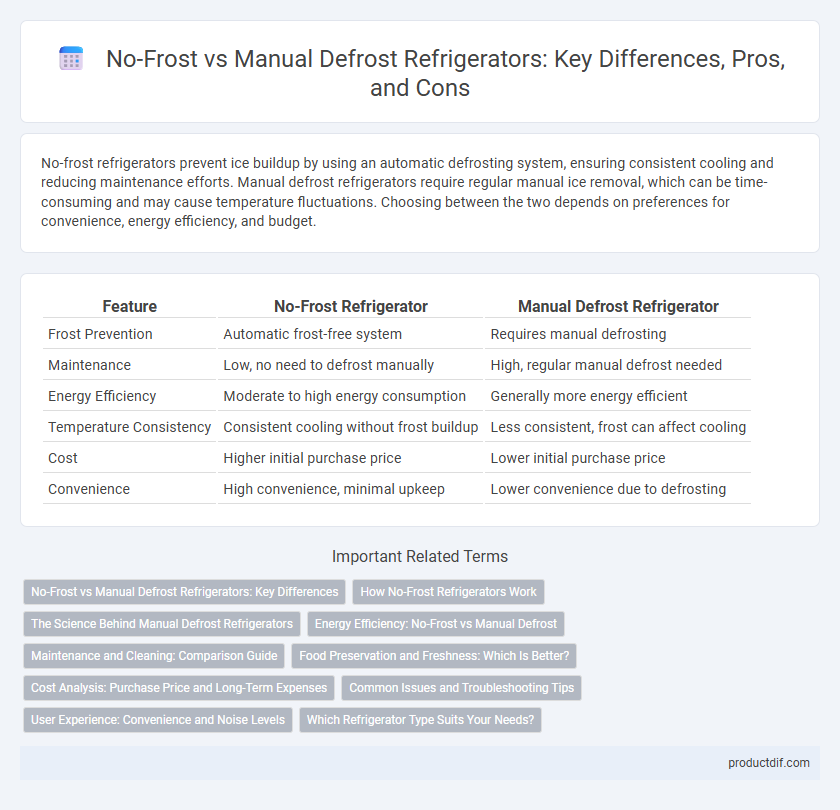No-frost refrigerators prevent ice buildup by using an automatic defrosting system, ensuring consistent cooling and reducing maintenance efforts. Manual defrost refrigerators require regular manual ice removal, which can be time-consuming and may cause temperature fluctuations. Choosing between the two depends on preferences for convenience, energy efficiency, and budget.
Table of Comparison
| Feature | No-Frost Refrigerator | Manual Defrost Refrigerator |
|---|---|---|
| Frost Prevention | Automatic frost-free system | Requires manual defrosting |
| Maintenance | Low, no need to defrost manually | High, regular manual defrost needed |
| Energy Efficiency | Moderate to high energy consumption | Generally more energy efficient |
| Temperature Consistency | Consistent cooling without frost buildup | Less consistent, frost can affect cooling |
| Cost | Higher initial purchase price | Lower initial purchase price |
| Convenience | High convenience, minimal upkeep | Lower convenience due to defrosting |
No-Frost vs Manual Defrost Refrigerators: Key Differences
No-Frost refrigerators use a built-in fan to circulate air and prevent ice buildup, eliminating the need for manual defrosting and maintaining consistent cooling performance. Manual defrost refrigerators require periodic defrosting to remove ice accumulation, which can lead to uneven temperatures and reduced energy efficiency. No-Frost models generally offer convenience and better temperature control, while manual defrost units tend to be more affordable but demand more maintenance.
How No-Frost Refrigerators Work
No-Frost refrigerators utilize a built-in fan and heating element to circulate dry, cold air evenly while preventing ice accumulation on the evaporator coils. This automatic defrosting mechanism eliminates the need for manual defrosting, maintaining consistent cooling efficiency and preserving food freshness longer. Advanced sensors regulate temperature and humidity inside the compartment, optimizing energy consumption and reducing frost buildup compared to manual defrost models.
The Science Behind Manual Defrost Refrigerators
Manual defrost refrigerators operate by allowing frost to accumulate naturally on the evaporator coils, requiring periodic defrosting to maintain efficiency and prevent ice buildup that hinders cooling performance. The science involves interrupting the cooling cycle to let the frost melt, either through manual defrosting or by turning off the appliance temporarily, which minimizes energy consumption compared to continuous defrost systems. This design simplifies the refrigeration system by eliminating automatic defrost heaters, resulting in fewer mechanical components and potentially longer appliance lifespan.
Energy Efficiency: No-Frost vs Manual Defrost
No-Frost refrigerators maintain consistent temperatures by automatically preventing ice buildup, resulting in more energy-efficient operation compared to manual defrost models that require frequent thawing. Manual defrost refrigerators consume less energy overall but demand regular defrosting to avoid ice accumulation that can reduce cooling efficiency. Energy Star ratings typically favor No-Frost models due to their ability to maintain optimal performance and lower operational energy costs over time.
Maintenance and Cleaning: Comparison Guide
No-frost refrigerators require minimal maintenance as they automatically prevent ice buildup, eliminating the need for manual defrosting and making cleaning easier. Manual defrost refrigerators need regular defrosting sessions, which can be time-consuming and may cause water spillage, requiring more frequent deep cleaning. Selecting a no-frost model enhances convenience by reducing maintenance efforts and ensuring more hygienic conditions inside the appliance.
Food Preservation and Freshness: Which Is Better?
No-Frost refrigerators use a fan system to circulate cold air evenly, preventing ice buildup and maintaining consistent temperatures that enhance food preservation and freshness by reducing moisture and freezer burn. Manual defrost refrigerators require regular defrosting to avoid ice accumulation, which can cause temperature fluctuations and negatively impact the longevity and quality of stored food. For optimal food preservation and maintaining freshness, No-Frost refrigerators provide more reliable temperature control and reduced risk of spoilage compared to manual defrost models.
Cost Analysis: Purchase Price and Long-Term Expenses
No-Frost refrigerators generally have a higher purchase price due to advanced frost prevention technology but offer reduced long-term expenses by eliminating manual defrosting and improving energy efficiency. Manual defrost refrigerators are initially less expensive but may incur increased energy costs and maintenance over time due to regular defrosting requirements. Evaluating lifetime energy consumption and maintenance frequency is crucial for a comprehensive cost analysis between the two models.
Common Issues and Troubleshooting Tips
No-Frost refrigerators often encounter frost buildup in the evaporator coil, causing airflow obstructions that reduce cooling efficiency; regularly checking and defrosting the coils can prevent this issue. Manual defrost refrigerators require users to manually remove frost accumulation, which can lead to uneven cooling and water leakage if not maintained properly; scheduling periodic defrost cycles and ensuring the door seal integrity helps mitigate these problems. Both types benefit from routine cleaning of condenser coils and verifying thermostat settings to optimize performance and extend appliance lifespan.
User Experience: Convenience and Noise Levels
No-Frost refrigerators provide superior convenience by automatically preventing ice buildup, eliminating the need for manual defrosting and saving users time. These models typically operate with quieter compressors and fans, reducing ambient noise in the kitchen. In contrast, manual defrost refrigerators require regular ice removal, which can be labor-intensive, and their compressors often generate louder operational sounds, impacting user comfort.
Which Refrigerator Type Suits Your Needs?
No-Frost refrigerators offer convenience with automatic defrosting and consistent temperature control, ideal for busy households seeking low maintenance. Manual defrost refrigerators are typically more energy-efficient and cost-effective, appealing to those prioritizing budget and environmental concerns. Consider your lifestyle, energy consumption preferences, and maintenance willingness to determine which refrigerator type suits your needs best.
No-Frost Refrigerator vs Manual Defrost Refrigerator Infographic

 productdif.com
productdif.com